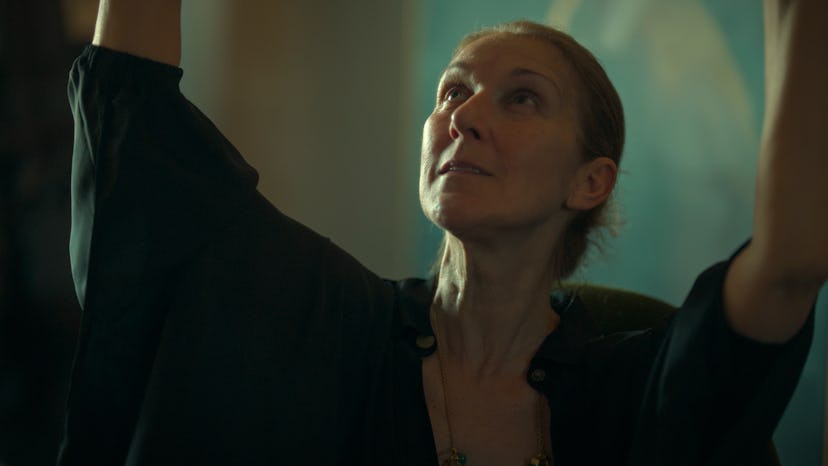An early scene of I Am: Celine Dion shows the five-time Grammy winner doing what she does best: belting the highest of notes. Fans of the Québécois singer—or really, anyone paying even mild attention to pop culture over the three decades—will instantly recognize the contours of Dion’s powerful vocals. It’s a reminder of why the 56-year-old music legend is so beloved—and of what she stands to lose in the current battle for her health and voice.
The documentary, now in theaters and streaming on Amazon Prime Video June 25, builds on an Instagram video that Dion posted back in December 2022. In the clip, a tearful Dion speaks directly to her fans, apologizing for canceling her four-year Las Vegas residency. “I’m sorry it’s taken me so long to reach out to you. I miss you so much,” she says, before revealing her medical condition: Stiff Person Syndrome (SPS), a rare autoimmune neurological disorder that causes painful muscle stiffness and spasms. Her message is one of devastation and remorse for letting down her fans—and in many ways, that’s the central note of I Am: Celine Dion.
“She canceled her brand-new residency a week before it was about to start. You can imagine all the people that affected,” the movie’s director, Irene Taylor (Leave No Trace, Moonlight Sonata: Deafness in Three Movements), tells W. When filming began, Dion hadn’t yet received a diagnosis for the condition that had been plaguing her in some capacity, she now knows, for nearly two decades.
For that reason, I Am: Celine Dion is less a classic celebrity bio-doc than a snapshot of a very difficult time in a life otherwise marked by “tremendous fortune,” as Taylor puts it. The most heart-wrenching scenes show Dion in the throes of her illness, tears streaming down her frozen face as paramedics coach her through agonizing muscle spasms. She’s most distressed when talking about (or demonstrating) the effect SPS has had on her vocal range and strength.
Celine Dion singing in I Am: Celine Dion
Still, lighter moments are mixed in—including archival footage of the ever-polished Dion belting mega-hits like 1997’s “My Heart Will Go On,” and cozy scenes of the singer at home with her children. (There’s also a fun break where she shows off her massive warehouse of clothes, saying of her size 6-10 shoe collection, “When a girl loves her shoes, she always makes them fit.”) Footage of her wearing outfits from her collaboration with Law Roach make it into the film, too—and in between the tears, Dion’s signature silliness is often on display, reminding us what a true showman she is.
Below, Taylor shares Dion’s approach to making the intimate documentary and why there were no boundaries in filming:
Why did Celine want to make this film?
I think it was the pandemic, and her slowing down—she became very reconnected with her kids. As she put it, “I was being brave for 17 years, not telling anyone about this, except my close friends and my family, but now it was time to be smart.” She realized she was a single mother, and she did not want to orphan her children. She was driving herself so hard, and she was propping herself up on medication so that she could walk and function.
For 17 years, she’s been struggling this?
For 17 years. She talked about how much Valium she took. Celine is not a pill-popper. She doesn’t drink. She’s very straight. If she’s addicted to anything, it’s singing and telling jokes.
There isn’t much talk of her personal life, but the scenes of her experiencing symptoms are extremely vulnerable. What boundaries did she have with filming?
She did not give me any boundaries. It’s my understanding that she watched some of my films, and had a sense of where I go and don’t go. Celine told me things that a different kind of filmmaker would’ve taken and ran with. I was really not interested in answering 10-year-old questions about gossip. I was sort of blissfully unaware of that stuff, because I didn’t research her. I was not a fan. I respected her, and grew up with her. I could sing plenty of her songs. But once I found out she was sick, I was really only interested in what was right in front of me.
It’s clear how responsible she feels for everyone around her. Did you ever think she was too hard on herself?
My personal feeling is that she was too hard on herself, but I put myself in her shoes, and I get it. People would be like, “How can you be so sick if you just did this very athletic performance last night? How is that possible?” We all know what it’s like to feel invalidated. Throughout history, the word hysteria has been correlated with womanhood. She was worried about people just not believing her. When she lost the fan component, it was a really hard adjustment for her.
What do you think, or hope, is next for her?
You could say that Celine is technically disabled by this disease. It may be that she’s no longer hitting the so-called money notes, but now she’s singing with a different kind of intensity. Maybe she’s choosing a different repertoire. Maybe she’s going to collaborate with new artists that she wouldn’t have thought to collaborate with, or new songwriters. It may be that she’s taken out of the pop music canon and put into some new place, so that this disability is actually a superpower. There’s going to be something on the other side of this, and we’re going to hear a lot from her.
